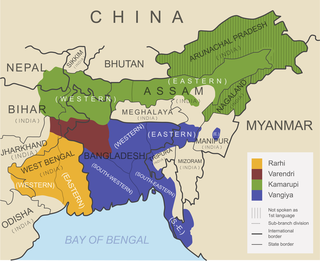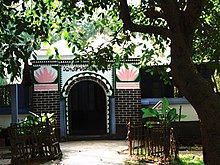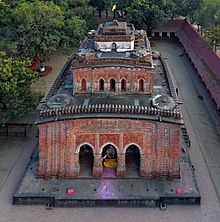
Bengal is a historical geographical, ethnolinguistic and cultural term referring to a region in the eastern part of the Indian subcontinent at the apex of the Bay of Bengal. The region of Bengal proper is divided between the modern-day sovereign nation of Bangladesh and the Indian states of West Bengal, and some parts of Assam, Tripura, Jharkhand and Bihar.

The music of West Bengal includes multiple indigenous musical genres such as Baul, Ramprasadi, Bishnupuri Classical, Kirtan, Shyama Sangeet, Rabindra Sangeet, Nazrul Geeti, Dwijendrageeti, Prabhat Samgiita, Agamani-Vijaya, Patua Sangeet, Gambhira, Bhatiali, Bhawaiya, Bengali Rock.

Bengalis, also rendered as endonym Bangalee, are an Indo-Aryan ethnolinguistic group originating from and culturally affiliated with the Bengal region of South Asia. The population is divided between the sovereign country Bangladesh and the Indian regions of West Bengal, Tripura, Barak Valley, Goalpara, Andaman and Nicobar Islands, and parts of Meghalaya, Manipur and Jharkhand. Most speak Bengali, a classical language from the Indo-Aryan language family. Sub-section 2 of Article 6 of the Constitution of Bangladesh states, "The people of Bangladesh shall be known as Bengalis as a nation and as Bangladeshis as citizens."

The dotara is a two-stringed, plucked musical instrument from South Asia, with most contemporary models having four playing strings. Comparatively, the sarod is a slightly larger and more elaborate instrument, being built with an additional set of resonant sympathetic strings. However, the dotara is still quite resonant and projective of its own sound, due to its rounded shape and overall construction. It is commonly played in Bangladesh and the Indian states of Assam, West Bengal and Bihar. It was mentioned in a 14th-century Saptakanda Ramayana. Later, it was adopted by the ascetic cults of Bauls and Fakirs. Today, it is also used to play Hindustani Classical Ragas.

Bhawaiya is a musical form or a popular folk music that originated in Northern Bengal, especially the Rangpur Division in Bangladesh, Cooch Behar district of West Bengal, India, and the undivided Goalpara district of Assam, India. It has recurrent themes of the "working class", mahouts, mahishals, and gariyals. Lyrics express pangs of separation and loneliness of their womenfolk, with elongated tones accentuating pain, longing and "deep emotion". Bhawaiya is generally believed to have originated in the 16th century under Biswa Singha, and has evolved into stage performances since the 1950s. The lyrics of Bhawaiya songs are non-denominational. Bhawaiya is really popular during the Bengali occasion of Eid Al Fitr and Eid Al Adha.
Goalpariya is a group of Indo-Aryan dialects spoken in the Goalpara region of Assam, India. Along with Kamrupi, they form the western group of Assamese dialects. The North Bengali dialect is situated to its west, amidst a number of Tibeto-Burman speech communities. The basic characteristic of the Goalpariya is that it is a composite one into which words of different concerns and regions have been amalgamated. Deshi people speak this language and there are around 20 lakhs people.

The Bengali dialects or Bengali varieties are the varieties of the Bengali language, an Eastern Indo-Aryan language of the Indo-European language family, widely spoken in the Bengal region of South Asia. The spoken dialects of Bengali are mutually intelligible with neighbouring dialects.

Rangpuri is an eastern Indo-Aryan language of the Bengali-Assamese branch, spoken in Rangpur Division in Bangladesh, northern West Bengal and western Goalpara of Assam in India. Many are bilingual in Bengali and Assamese in their respective regions. According to Glottolog, it forms the Central-Eastern Kamta group with the Kamta language. Together with Rajbanshi and Surjapuri they form the Kamta group of languages.

The culture of Bengal defines the cultural heritage of the Bengali people native to eastern regions of the Indian subcontinent, mainly what is today Bangladesh and the Indian states of West Bengal and Tripura, where they form the dominant ethnolinguistic group and the Bengali language is the official and primary language. Bengal has a recorded history of 1,400 years. After the partition, Bangladeshi culture became distinct from the mainstream Bengali culture, thus their culture evolved differently, still there are many commonalities in Bangladeshi culture & West Bengali culture which connects them both together as Bengali culture.
The national language and official language of Bangladesh is Bangla according to the third article of the Constitution of Bangladesh. Almost 99% of Bangladeshis speak Bengali as their first language. Bengali Language Implementation Act, 1987 made it mandatory to use Bengali in all government affairs except in the cases of foreign relations. According to a 2022 census, Bengali is predominantly spoken by 99% of the country's population and it also serves as the national language of the nation. The indigenous people of northern and southeastern Bangladesh speak a variety of native languages. According to the Ethnologue, there are 36 indigenous living languages, which include 17 Tibeto-Burman, 10 Indo-Aryan, 7 Austroasiatic and 2 Dravidian languages in Bangladesh. Bangladesh has 44 indigenous languages according to Professor Shameem Reza.

The Eastern Indo-Aryan languages, also known as Māgadhan languages, are spoken throughout the eastern region of the Indian subcontinent, which includes Bihar, Uttar Pradesh, Jharkhand, Bengal region, Tripura, Assam, and Odisha; alongside other regions surrounding the northeastern Himalayan corridor. Bengali is official language of Bangladesh and the state of West Bengal, Tripura and the Barak valley of Assam while Assamese and Odia are the official languages of Assam and Odisha, respectively. The Eastern Indo-Aryan languages descend from Abahattha, which descends from Magadhan Apabhraṃśa and ultimately from Magadhi Prakrit.

The Rajbanshi, also Rajbongshi and Koch-Rajbongshi, are peoples from Lower Assam, North Bengal, eastern Bihar, Terai region of eastern Nepal, Rangpur division of North Bangladesh and Bhutan who have in the past sought an association with the Koch dynasty. Koch-Rajbanshi people speak Kamatapuri, an Indo-Aryan language, likely due to language shift, and in the past they might have spoken Tibeto-Burman languages. The community is categorised as OBC in Assam and Bihar, and SC in West Bengal. In Nepal they are considered part of the Plains Janjati. In Bangladesh the community is classified as Plains ethnic group under 'Barman'. They are the largest Scheduled Caste community of West Bengal.
Surjapuri is an Indo-Aryan language of the Bengali-Assamese branch, spoken in Eastern India including North Bengal, West Bengal, and some eastern parts of Purnia division of Bihar, as well as Jhapa District in Nepal, Goalpara Division of Assam in India and Rangpur Division in Bangladesh. Among speakers in some regions, it is known as 'Deshi Bhasa'. It possesses similarities with Kamatapuri, Assamese, Bengali, and Maithili.

KRDS lects are a cluster of modern lects that are phylogenetic descendants of the proto-Kamta language. The proto-Kamta language began differentiating after 1250 around Kamatapur, the capital city of Kamata kingdom, as the western branch of the proto-Kamarupa, whereas the eastern branch developed into proto-Assamese. Since the 16th century the proto-Kamta community has fragmented giving rise to the differentiated modern lects. The modern lects are: Kamta, Rangpuri (Bangladesh), Rajbanshi (Nepal) and Surjapuri (Bihar).

The Bengali-Assamese languages is a grouping of several languages in the eastern Indian subcontinent. This group belongs to the Eastern zone of Indo-Aryan languages. The languages in this group according to Glottolog includes Assamese, Bengali, Bishnupriya, Chakma, Chittagonian, Hajong, Kharia Thar, Kurmukar, Mal Paharia, Noakhali, Rajbangshi, Rohingya, Sylheti, Tangchangya and Surjapuri.

The Sylheti or Sylhetis are an Indo-Aryan ethnocultural group, that are associated with the Sylhet region. There are strong diasporic communities in Barak Valley of Assam, India, North Tripura, Shillong, Meghalaya, and Hojai, Central Assam. Outside South Asia, there are significant numbers in the United Kingdom, the United States, and Canada.

Bengali Muslims are adherents of Islam who ethnically, linguistically and genealogically identify as Bengalis. Comprising over 70% of the global Bengali population, they are the second-largest ethnic group among Muslims after Arabs. Bengali Muslims make up the majority of Bangladesh's citizens, and are the largest minority in the Indian states of West Bengal, Tripura and Assam.
The Miya people, alternatively identified as Na-Asamiya by themselves, denote the progeny of Bengali Muslim migrants originating from the contemporary Mymensingh, Rangpur, and Rajshahi Divisions. These individuals established residence in the Brahmaputra Valley during the 20th century, coinciding with the period of British colonial rule in Assam. The migration of the Miya people was actively promoted by the Colonial British Government from the Bengal Province, spanning the years 1757 to 1942. This migratory trend persisted until the year 1947. Presently, the term "Miya" is employed as a discriminatory label.
Rajbanshi is a Bengali-Assamese language spoken in Nepal. It is related to, but distinct from Rangpuri/Kamta in Bangladesh and India, which is also known by the alternative name "Rajbanshi", with which it forms the KRNB cluster.

Deshi or Uzani people are an indigenous Muslim community residing mostly in Assam and other parts of eastern India. The Deshi Muslim people can be find in Meghalaya, North Bengal, eastern Bihar, Rangpur and Bogura of Bangladesh. In West Bengal and Bihar they are known as Nashya Shaikh. Deshis are Muslim converts from Koch, Mech or other indigenous communities. In July, 2022, the Government of Assam gave them recognition as an "Indigenous Assamese Muslims" community vide an Order.























